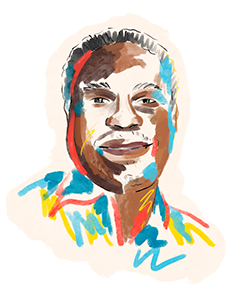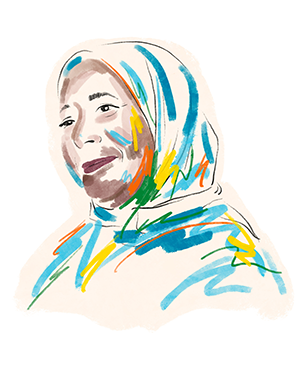Social workers play an important role in health care, even more so as health care services become increasingly integrated. The impact that social workers have on their patients, the patients’ families and the health care team as a whole varies depending on the setting and the specialty. However, the one constant is social workers’ ability to connect their patients with the resources and additional services they need. Such is the case with palliative care.
For example, the Veterans Health Administration published a study in January of this year that analyzed the records of 43,200 veterans receiving care through a Veterans Affairs health care site. The veterans, whose average age was about 65 and all of whom
had been recently hospitalized, were found to be 95% more likely to access palliative and hospice care if they were connected to a social worker through their primary care physician. In this case, all of the health care providers were connected to the Social Work Patient Aligned Care Team (PACT), a health care model that works with veterans and their health care professionals to focus on
whole-person, lifelong health and wellness.

These findings come as no surprise to social workers, particularly those in palliative care or another medical field. Nonetheless, they serve as a reminder that while palliative care is invaluable to patients dealing with long-term and life-limiting illnesses, it is a service that is often underused and misunderstood. According to the World Health Organization, while there are an estimated 56.8 million people globally in need of palliative care each year, only about 14% of individuals receive it.
Social workers play a key part in changing that. Through education, relationship-building and a commitment to palliative care, social workers can help ensure more patients and their families are fully informed of the discipline and take advantage of the access that already exists.
The Myth
For more patients to access palliative care, more patients and their families need to fully understand what palliative care is. There is a common misconception—or as Kathryn S. Gurland, LCSW, calls it, a myth—that palliative care and hospice or end-of-life care are one and the same.
“The phrase you hear is, ‘We can’t do anything more for you, so we’re referring you to palliative care,’” says Gurland, the director and founder of PEG’S Group LLC in New York. “That’s the worst (way to put it).
The palliative care team is looking at the holistic person. It is a service that looks at everything but the cure. They’re looking at appetite. They’re looking at mood. They’re looking at fatigue—the whole person. That really does improve the patient.”
Palliative care addresses the symptoms of a long-term illness, such as pain, loss of appetite, difficulty sleeping, depression and more. While not curative, palliative care can be delivered in tandem with curative care. A patient diagnosed with cancer, for example, can receive both chemotherapy (or radiation) and palliative care.
“(Palliative care) providers have a special expertise in being able to address the symptoms and stressors of a serious illness. They are looking at strategies to improve quality of life and function for the person, and they are aware of and addressing the needs of the individual and the social network of the individual. We have again that broader perspective. We don’t make the cancer go away, but the palliative care service works in concert with the oncologist, nephrologist, etc., so that the person’s experience with that illness is as positive as it can be,” says Shirley Otis-Green, MSW, ACSW, LCSW, OSW-CE, FNAP, FAOSW, founder and consultant of Collaborative Caring in Toluca Lake, Calif.

This is different from hospice.
“With palliative care as a discipline, a patient can still receive what some hospice practitioners would call life-prolonging care,” explains Karen Bullock, PhD, LICSW, FGSA, APHSW-C, Louise McMahon Ahearn Endowed Professor in the Boston College School of Social Work.
“Hospice has a very specific definition tied to reimbursement. The person has to have a diagnosis that is going to limit their life. The doctor has to confirm that the person is only going to live six months.”
She adds that a patient may be recertified for hospice if they live beyond six months. However, many reach the end of their life long before then.
Confusing palliative care with hospice care can lead to automatic refusal of the service if—often when—it is not properly explained to the patient and family. All of the social workers interviewed for this article agree it
is a major public relations problem.
“People associate palliative care with dying,” says Barbara L. Jones, PhD, MSW, FNAP, dean of the Boston University School of Social Work. “In pediatrics, you can imagine the weight then of accepting a palliative care referral.” However, when families understand the broader definition of palliative care, they are less resistant and more likely to accept the service, she says.
With that in mind, Otis-Green notes it is important for those discussing a palliative care consult to actually discuss it. Using shorthand or simply asking a patient and their family if they would like to meet the palliative care team does not provide the patient with enough context for an informed decision.
Caitlin Scanlon, MSW, LCSW, a fellowship-trained pediatric palliative care social worker and New York/New Jersey-based psychotherapist, suggests going a step further. Rather than asking the family if they are willing to meet with a palliative care professional or team, bring palliative care workers in to discuss what the team can do for the patient. “You wouldn’t ask the family, ‘Is it OK if we do a cardiology consult?’” she says. A cardiology referral, when needed, would simply be made. Scanlon says when the team asks the family if it is OK to consult palliative care, it “sets the stage that (palliative care) is not needed and increases the worry around what it means for palliative care to be called in.”
Professional Messaging
A full understanding of palliative care is not just an issue for patients, however. The professionals referring to palliative care also need to have a basic knowledge of the discipline.
The social workers working with the veterans in the VHA study were connected to the primary care physicians, not the palliative care team, for example. It was their knowledge that opened the door to palliative care. It is the professionals—whether social workers, chaplains, nurses or doctors—in other disciplines who are ultimately the gatekeepers of resources like palliative care. When they are misinformed or know little about palliative care, they will not make the appropriate referral or call in the palliative care team for a consultation.
“It is still a very new concept and still very misunderstood,” says Gurland. “Fixing that rests on the shoulders of palliative care. It is their duty to market themselves to all departments.” Doing so could allow, for example, a woman with Stage 2 breast cancer to access palliative care. Palliative care would help her manage the fatigue, nausea and other symptoms related to a stage of cancer that is not a marker of the end of life but is a challenging and symptomatic stage nonetheless. “No one thinks of palliative care for Stage 2, but there’s no reason they shouldn’t have a palliative consult,” she says.
Building an understanding of palliative care among other health care professionals requires more than an explanation of the specialty. Collaboration also must be discussed, so that the additional teams in a patient’s life have the opportunity to see how they and palliative care are pieces in the same puzzle.
“What we need to be doing now is not creating separation with our health care social work colleagues but rather joining the skill sets,” says Terry Altilio, LCSW, APHSW-C, a palliative social work educator in the Northeast. “My concern and my wondering is did we build a specialty and at the same time separate ourselves?” Altilio emphasizes the need for social workers to affirm the work of their colleagues. In doing so, care providers—whether providing palliative or curative care—can find the most effective way to work together to meet the needs of the patient and their family.
Messaging around palliative care is only one step in the process, however. The public relations problem extends to social work, too—a significant challenge when/if social workers are the ones tasked with informing patients of the availability of such specialties. When health care teams don’t recognize the value of a social worker or do not have the resources to hire an adequate number of social workers, patients again miss out. All health care professionals should be informed enough about palliative care or social work (if not both) so that the patient has a greater opportunity to access the care.
Additional Barriers to Care

Proper understanding and messaging to all parties will not increase the use of palliative care alone. There are additional barriers to care that a social worker is often best equipped to navigate, particularly given their complexity.
Administratively, insurance can be a barrier as well as the ability to physically access palliative care. While community-based palliative care is becoming more common, most palliative care teams work within a hospital or health care facility, requiring the patient to travel to them.
Within that facility, the funding needs to be present for a full or even partial palliative care team to exist. That can be hard to justify, as palliative care does not function the same way financially as do curative care teams.
“Palliative care is not a moneymaker,” says Boston University’s Jones. “You have to have a commitment to palliative care to fund palliative care.” And while palliative care can actually be a cost-saver for health care providers in the long run, it does require an initial investment—an investment that health care organizations may not always want to make. Added to that, it is difficult, though not impossible, to clearly define and demonstrate the outcomes of palliative care, Jones says.
“It’s hard to measure. Measuring palliative care is kind of like measuring social work,” she says. Both the specialty of palliative care and the profession of social work are skilled at filling in the gaps, addressing needs that might not otherwise be met, but in doing so it can be difficult to put the value of both on paper or into a key performance indicator.
Deeper Challenges
Outside of administrative barriers, social workers and their palliative care teams must recognize the systemic and historic challenges that exist in helping individuals access palliative care. There are many reasons beyond messaging and education that an individual may decline a referral.
For example, people of color in the United States, particularly individuals who have been historically excluded, denied access to, and/or underserved in the health care system, have long had reason not to trust that system. “Fewer people of color utilize hospice and palliative care than white populations,” says Boston College’s Bullock. “There are a number of factors that make it challenging for people of color to accept hospice care—in particular, people whose ancestors were enslaved. People have a challenging time saying yes for a host of cultural reasons, with mistrust of the hospital system being one factor. U.S. hospitals were segregated until 1965.” She notes that even once laws prohibiting discrimination based on race went into effect, it took much longer for actual change to occur.
Bullock also points to historic atrocities such as the Tuskegee experiment—the U.S. Public Health Service-run syphilis study that began in 1932 and continued into the 70s. Many older adults—those most likely to be eligible for palliative care—have distinct memories
of these events. Also, “most doctors who provide the care are white, most nurses, most social workers who provide the care are white,” Bullock says. “And now health care systems expect [people of color] to say, ‘Oh yes, I’ll be right there!’” when offered palliative care.
This is a barrier that cannot be overcome quickly. It is complex and understandable. However, the right social worker may have the training and experience to work with patients to build enough confidence in the health care system to open the door to the possibility of palliative care.
Social Work Opportunity

For social workers, increasing access and use of palliative care is a multitiered process—from messaging and education to working through both administrative and more complicated, whole-person and systemic challenges. It is not a simple task and yet it is an important one.
Social workers are working to bring a greater knowledge of palliative care to their own profession and to those with whom they collaborate. There are core competencies for social workers working in adult palliative care, as well as pediatric palliative care. Pediatric palliative care social worker Scanlon notes that she and several of her colleagues published competencies for pediatric palliative care in 2022 in their article “Defining Core Competencies and a Call to Action: Dissecting and Embracing the Crucial and Multifaceted Social Work Role in Pediatric Palliative Care.”
Myra Glajchen, DSW, MSW, ACSW, APHSW-C, said she and others—including Collaborative Caring’s Otis-Green—published the landmark article “Defining Core Competencies for Generalist-Level Palliative Social Work” in 2018.
In addition, Glajchen developed the ESPEC program, which stands for Educating Social Workers in Palliative and End-Of-Life Care. The training program, which includes self-paced, instructor-led, and leadership training, as well as monthly mentorship opportunities, launched in 2021 in collaboration with NASW.
Glajchen was the ESPEC project director, but she asked Otis-Green to be a co-director during the COVID-19 pandemic. Glajchen also is the associate program director for the Fellowship Training Program at MJHS Institute for Innovation in Palliative Care in New York and an assistant professor in the Department of Family and Social Medicine at Albert Einstein College of Medicine.
Glajchen notes there is a troubling workforce shortage in palliative care, hospice care, and health care social work. She says education and training are key to solving this shortage.
“Social workers are core members of the health care team, well-qualified to take leadership roles across health care settings, “ she said. Yet because of the workforce shortage, “most patients and families will not have access to a palliative social worker during the course of serious medical illness, and, too often, social workers' roles have been defined by other disciplines.”
“While historic and current challenges are many,” she continued, “I remain optimistic that education and training can help to ameliorate these shortfalls, level the playing field with other disciplines, and empower social workers to work to the top of their licenses. ESPEC is one such program, designed by social workers for social workers, to help promote the integration of the principles and practices of palliative care into generalist social work practice.”
Sue Coyle, MSW, is a freelance writer and social worker in the Philadelphia suburbs.